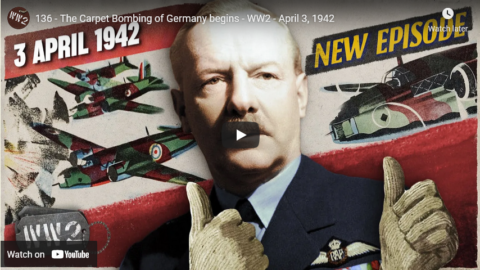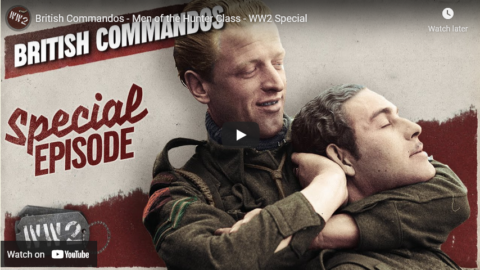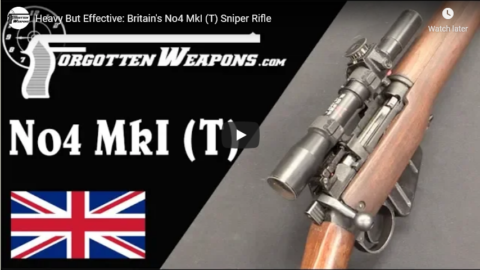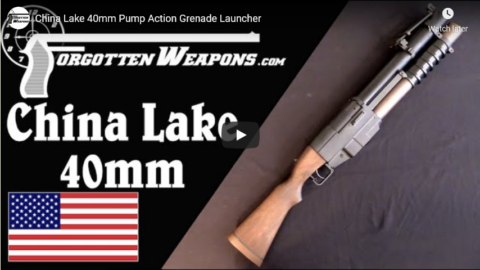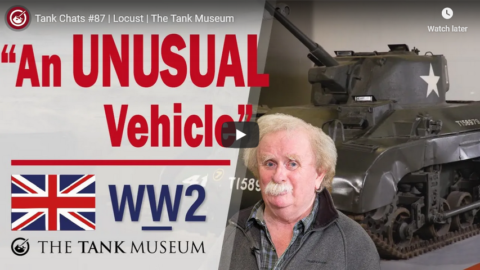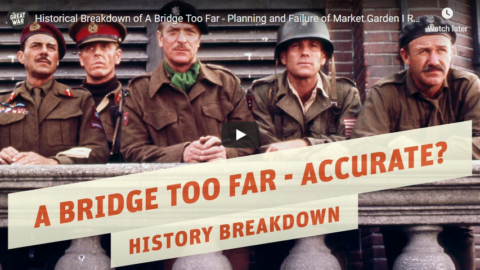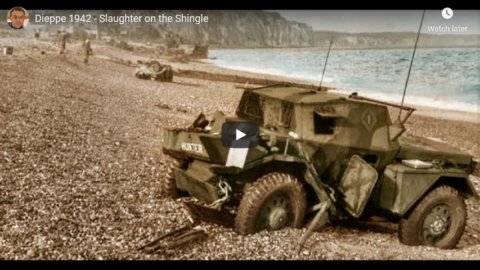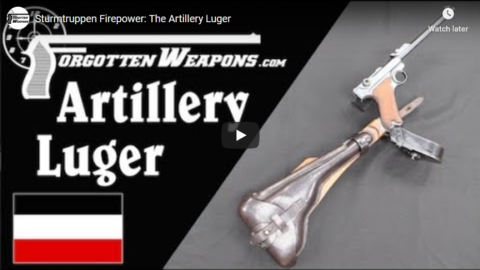World War Two
Published 12 Aug 2021Astrid talks about spying all the time, but what was it actually like for people on the ground? We look through the lens of the British Special Operations Executive (SOE) to find out!
(more…)
August 13, 2021
Spycraft and the Special Operations Executive – WW2 – Spies & Ties 07
June 16, 2021
By Sea, By Land – A Global History of the Marines – WW2 Special
World War Two
Published 15 Jun 2021Naval infantrymen have long been a feature of warfare. In the build-up to 1939, they took on new functions and tactics. The Royal Marines, the US Marine Corps, Black Death, Kaiheidan, and more are ready for all-out amphibious warfare in the Pacific Theatre and beyond.
(more…)
May 28, 2021
The Plot to Kill Hitler’s Hangman – Operation Anthropoid – WAH 035 – May 1942, Pt. 2
World War Two
Published 27 May 2021Arthur Harris and his RAF Bombers carry out a massive bombing raid on Cologne. Meanwhile, one of the architects of the Holocaust, Reinhard Heydrich is the target of a spectacular assassination attempt.
(more…)
April 4, 2021
The Carpet Bombing of Germany begins – WW2 – 136 – April 3, 1942
World War Two
Published 3 Apr 2021Britain’s campaign to firebomb the old towns of Germany where civilians reside begins in earnest this week. The British also destroy the port at St. Nazaire in commando action. In the Indian Ocean, however, they are avoiding contact with the Japanese, even while on land the Japanese advance in both Burma and New Guinea.
Check out Indy’s Tie Barn to get your own tie right here: https://www.youtube.com/c/IndysTieBar…
Join us on Patreon: https://www.patreon.com/TimeGhostHistory
Or join The TimeGhost Army directly at: https://timeghost.tvFollow WW2 day by day on Instagram @ww2_day_by_day – https://www.instagram.com/ww2_day_by_day
Between 2 Wars: https://www.youtube.com/playlist?list…
Source list: http://bit.ly/WW2sourcesWritten and Hosted by: Indy Neidell
Director: Astrid Deinhard
Producers: Astrid Deinhard and Spartacus Olsson
Executive Producers: Astrid Deinhard, Indy Neidell, Spartacus Olsson, Bodo Rittenauer
Creative Producer: Maria Kyhle
Post-Production Director: Wieke Kapteijns
Research by: Indy Neidell
Edited by: Iryna Dulka
Sound design: Marek Kamiński
Map animations: Eastory (https://www.youtube.com/c/eastory)Colorizations by:
– Daniel Weiss
– Carlos Ortega Pereira, BlauColorizations – https://www.instagram.com/blaucolorizations
– Election1960 from Wiki CommonsSources:
– Bundesarchiv – 101II-MW-3722-03
– IWM C 2351, A 11787, H_018753_1, R 1827Soundtracks from the Epidemic Sound:
– Rannar Sillard – “Easy Target”
– Edward Karl Hanson – “Spellbound”
– Phoenix Tail – “At the Front”
– Jo Wandrini – “Dragon King”
– Phoenix Tail – “Last Minute Reaction”
– Craft Case – “Secret Cargo”
– Fabien Tell – “Last Point of Safe Return”
– Howard Harper-Barnes – “Underlying Truth”
– Flouw – “A Far Cry”
– Fabien Tell – “Break Free”
– Wendel Scherer – “Time to Face Them”Archive by Screenocean/Reuters https://www.screenocean.com.
A TimeGhost chronological documentary produced by OnLion Entertainment GmbH.
March 31, 2021
British Commandos – Men of the Hunter Class – WW2 Special
World War Two
Published 30 Mar 2021After the German take over continental Europe, the British invent the commando, a new soldier type to raid and harass German installations in occupied Europe.
Join us on Patreon: https://www.patreon.com/TimeGhostHistory
Or join The TimeGhost Army directly at: https://timeghost.tvFollow WW2 day by day on Instagram @ww2_day_by_day – https://www.instagram.com/ww2_day_by_day
Between 2 Wars: https://www.youtube.com/playlist?list…
Source list: http://bit.ly/WW2sourcesHosted by: Indy Neidell
Written by: Joram Appel
Director: Astrid Deinhard
Producers: Astrid Deinhard and Spartacus Olsson
Executive Producers: Astrid Deinhard, Indy Neidell, Spartacus Olsson, Bodo Rittenauer
Creative Producer: Maria Kyhle
Post-Production Director: Wieke Kapteijns
Research by: Joram Appel
Edited by: Karolina Dołęga
Sound design: Marek Kamiński
Map animations: Eastory (https://www.youtube.com/c/eastory)Colorizations by:
– Daniel WeissSources:
– Imperial War Museums: N 3, HU41240, A 26238, H17472, B 5203, H 19272, CH 10705, H 17489, D 8893, H 39031, A 17763, H 17502, TR1425, E 6390,E 6404, H 31439, TR1230, ADM 5072, H39029, H 17485, H 17347, H 022592, H 17511,H 22588, H 019284, H19269, NA 12466, N 530, NA12469, H18957, H 22604, A 27469, NA 379 A,N397 1941, C2352,H 17364, 023574,H 039033
– Bundesarchiv
– National Archives NARA
– National Military Museum
– Icons from the Noun Project: barge by Seb Chmiel, soldier by Wonmo Kang,
– Crickets sound courtesy of damonmensch
– Slide projector courtesy of hpebley3Soundtracks from the EpidemicSound:
– “London” – Howard Harper-Barnes
– “March Of The Brave 10” – Rannar Sillard
– “Rememberance” – Fabien Tell
– “The Inspector 4” – Johannes BornlöfArchive by Screenocean/Reuters https://www.screenocean.com.
A TimeGhost chronological documentary produced by OnLion Entertainment GmbH.
March 17, 2021
Heavy But Effective: Britain’s No4 MkI (T) Sniper Rifle
Forgotten Weapons
Published 29 Aug 2018http://www.patreon.com/ForgottenWeapons
Cool Forgotten Weapons merch! http://shop.bbtv.com/collections/forg…
The main British sniper rifle of World War Two, and arguably one of the best looking military sniper rifles of all time, the No4 MkI (T) was something the British military knew they would want even before the No4 MkI rifle had gone into real production. The first No4 snipers were built on leftover trials rifles from Enfield, and the pattern was formally introduced in February of 1942. First use was in North Africa, but the fighting there was not really suited to sniper rifles, and the weapon’s practical combat debut was in Italy in 1943.
The No4 MkI (T) was a conversion of a standard No4 MkI rifle, using examples chosen for particular good accuracy. They were sent to Holland & Holland to have scope mount bases added and No32 telescopic sights fitted (along with cheek risers on the stocks and having the battle sight aperture ground off to allow room for the scope bell). Between 23,000 and 26,000 were made during the war, and they would continue to be used in the British military for decades, including later conversion into 7.62mm NATO L42A1 rifles [which Ian discusses here].
Contact:
Forgotten Weapons
6281 N Oracle #36270
Tucson, AZ 85704
March 14, 2021
China Lake 40mm Pump Action Grenade Launcher
Forgotten Weapons
Published 11 Dec 2020http://www.patreon.com/ForgottenWeapons
https://www.floatplane.com/channel/Fo…
Cool Forgotten Weapons merch! http://shop.bbtv.com/collections/forg…
Possibly the coolest small arm used by the United States in the Vietnam War was the China Lake 40mm pump action grenade launcher. Only 24 of these were made, each fitted by hand. Of those, 2 went to MACVSOG, 2 to Army Force Recon, and the remaining 20 the the Navy SEALS. They were used as an ambush initiation weapon, with 4 rounds of rapid-fire 40mm HE grenades available.
Only five original examples survive today; four in US museums and military institutions and one in a museum in Saigon. An effort was made in 2004 to build reproductions, it is one of those used in this video. This project was not ultimately successful, but did lead to a very interesting series of events with the Airtronic company and the US Marine Corps, which will be detailed in a following video. Special thanks to Dutch Hillenburg and Kevin Dockery for making this video possible!
Contact:
Forgotten Weapons
6281 N. Oracle #36270
Tucson, AZ 85740
December 3, 2020
Tank Chats #87 | Locust | The Tank Museum
The Tank Museum
Published 25 Oct 2019David Fletcher looks at the M22, dubbed the ‘Locust’ by the British during WW2. The M22 saw service with the British Airborne during the Rhine Crossing in 1945.
Support the work of The Tank Museum on Patreon: ► https://www.patreon.com/tankmuseum
Visit The Tank Museum SHOP: ► https://tankmuseumshop.org/
Twitter: ► https://twitter.com/TankMuseum
Instagram: ► https://www.instagram.com/tankmuseum/
Tiger Tank Blog: ► http://blog.tiger-tank.com/
Tank 100 First World War Centenary Blog: ► http://tank100.com/
#tankmuseum #tanks
December 1, 2020
Pattern 14 MKI W (T) – The Best Sniper Rifle of World War One
Forgotten Weapons
Published 30 Aug 2017When World War One began, the British did not have a formal sniping program, and by 1915 the British found themselves thoroughly outclassed by the Germans in this area. They responded by developing tactics and equipment for sniping, and by mid 1916 they had really outclassed the Germans. However, the mid-war British sniping rifles really left a lot to be desired, even if they were being used effectively in the field. There was no single military optic, instead a wide variety of commercial scopes were rounded up and put into use. The mounts for these scopes were offset to the left side of the rifles to allow for continued use of stripper clips. Clips were arguably not really necessary on these rifles, and the offset scopes led to substantial headaches in use, as they required calculating windage as well as elevation adjustments depending on range.
Through 1918, though, the British developed one of the best sniping rifles of the war, although it would be introduced too late to see virtually any front line service. This new rifle was a Winchester-made Pattern 1914 Enfield with a center-mounted optic, and was designated the P14 MkI W(T). The P14 rifles were more accurate than the SMLE, and the centrally mounted optic made for much simpler shooting. These rifles were deemed to be mechanically capable of 1.5 MOA shooting, with the practical expected group size being 3 MOA.
Three thousand of these P14 snipers’ rifles were assembled and kept in service after the end of the war, but in the mid 1930s a small additional batch of 79 were made for the Irish Free State by BSA. These were all eventually surplussed to the US, and the rifle in this video is one of those late-production guns.
http://www.patreon.com/ForgottenWeapons
Cool Forgotten Weapons merch! http://shop.bbtv.com/collections/forg…
If you enjoy Forgotten Weapons, check out its sister channel, InRangeTV! http://www.youtube.com/InRangeTVShow
November 19, 2020
Deception and Dust-ups – Desert Warfare Tactics – WW2 Special
World War Two
Published 18 Nov 2020When Allies and Axis clash on the deserts of North Africa, harsh and unique conditions force them to develop new tactics. From misdirection to new ways to move across the desert, all to gain an advantage over the enemy.
Join us on Patreon: https://www.patreon.com/TimeGhostHistory
Or join The TimeGhost Army directly at: https://timeghost.tvFollow WW2 day by day on Instagram @ww2_day_by_day – https://www.instagram.com/ww2_day_by_day
Between 2 Wars: https://www.youtube.com/playlist?list…
Source list: http://bit.ly/WW2sourcesHosted by: Indy Neidell
Written by: Marlon William Londoño and Francis van Berkel
Director: Astrid Deinhard
Producers: Astrid Deinhard and Spartacus Olsson
Executive Producers: Astrid Deinhard, Indy Neidell, Spartacus Olsson, Bodo Rittenauer
Creative Producer: Maria Kyhle
Post-Production Director: Wieke Kapteijns
Research by: Marlon William Londoño
Edited by: Miki Cackowski
Sound design: Marek Kamiński
Map animations: Eastory (https://www.youtube.com/c/eastory)Colorizations by:
Julius Jääskeläinen – https://www.facebook.com/JJcolorization/
Spartacus OlssonSources:
IWM E 18461, E 8361, E 10147, E 12630, E 12385, E 12375, E 21337, E 12410, HU 3715, E 21339, E 4350
Picture of John Hutton, courtesy of Coventry Society
Picture of Edwin Galligan, Steven Sykes and Fred Pusey, courtesy of Rick Stroud
Picture of Hugh Cott, courtesy of Selwyn College, Cambridge
Picture og Ralph Alger Bagnold, courtesy of National Portrait Gallery
from the Noun Project: sun by MRFASoundtracks from the Epidemic Sound:
Reynard Seidel – “Deflection”
Max Anson – “Ancient Saga”
Hakan Eriksson – “Epic Adventure Theme 4”
Rannar Sillard – “March Of The Brave 4”
Jon Bjork – “Force Matrix”Archive by Screenocean/Reuters https://www.screenocean.com.
A TimeGhost chronological documentary produced by OnLion Entertainment GmbH.
From the comments:
World War Two
6 hours ago
As we see the North African campaign ongoing in our week by week series, in today’s episode we take a closer look at the tactics and logistical developments that helped shaped that campaign.
October 28, 2020
QotD: The Gurkhas
For 20 years between the wars [Field Marshal Viscount Slim] was a Gurkha officer, as so many of the 14th Army’s fighting generals were. Indeed, for a time, they were known on the front as the “Mongol Conspiracy.” Slim loves the Gurkhas, whose language he speaks. His favourite stories are of Gurkhas. He tells of the paratroopers who were to jump at 300 feet. As they had never jumped before, their Havildar [Sergeant] asked if they might go a little nearer the ground for their first jump. He was told that this was impossible because the parachutes would not have time to open. “Oh,” said the Gurkha, “so we get parachutes, eh?”
October 1, 2020
Historical Breakdown of A Bridge Too Far – Planning and Failure of Market Garden I RHINELAND 45
The Great War
Published 30 Sep 2020Support our brand new World War 2 documentary about The Battle of the Rhineland (not to be released on YouTube): https://realtimehistory.net/rhineland45
After last year’s Downfall video (with over 1 million views!) we thought we look at another classic WW2 movie and give you a breakdown about the historical figures and background. Our pick this time: A Bridge Too Far.
» SUPPORT THE CHANNEL
Patreon: https://www.patreon.com/thegreatwar» OUR PODCAST
https://realtimehistory.net/podcast – interviews with World War 1 historians and background info for the show.» BUY OUR SOURCES IN OUR AMAZON STORES
https://realtimehistory.net/amazon *
*Buying via this link supports The Great War (Affiliate-Link)» SOURCES
A. Beevor, Arnhem: The Battle for the Bridges (2018)
B. Horrocks, Escape to Action (1960)
R. Neillands, The Battle for the Rhine 1944 (2005)
Builder, Bankes, Nordin, Command Concepts (1999)
www.pegasusarchive.org
www.nam.ac.uk/explore/market-garden
www.iwm.org.uk/history/the-story-of-operation-market-garden-in-photos» MORE THE GREAT WAR
Website: https://realtimehistory.net
Instagram: https://instagram.com/the_great_war
Twitter: https://twitter.com/WW1_Series
Reddit: https://reddit.com/r/TheGreatWarChannel»CREDITS
Presented by: Jesse Alexander
Written by: Jesse Alexander
Director: Toni Steller & Florian Wittig
Director of Photography: Toni Steller
Sound: Toni Steller
Editing: Toni Steller
Motion Design: Philipp Appelt
Mixing, Mastering & Sound Design: http://above-zero.com
Maps: Daniel Kogosov (https://www.patreon.com/Zalezsky)
Research by: Matthew Moss
Fact checking: Florian WittigChannel Design: Alexander Clark
Original Logo: David van StepholdContains licensed material by getty images
All rights reserved – Real Time History GmbH 2020
From the comments:
The Great War
6 hours ago
Support our brand new World War 2 documentary about The Battle of the Rhineland (not to be released on YouTube): https://realtimehistory.net/rhineland45 **We know that some of you don’t like the fact that we upload non-Great War content once in a while. But here are a few fun facts: Last year’s video about THAT scene from Downfall has been one of our most successful videos ever produced. It helped us spreading the word about our crowdfunding campaign last year and it also brought new subscribers to The Great War that hadn’t heard about it. And in the cut-throat world of the YouTube attention economy this is really important for our continued existence. Another “fun” fact: Both this video and the Downfall video were both claimed for copyright violation even though they clearly fall under fair use. We disputed and lost and now there is nothing we can do about the fact that someone else is earning money through our work. Just one of the reasons why it’s increasingly frustrating working with YouTube and why we are exploring other avenues for The Great War and our other projects.
August 29, 2020
Durs Egg Ferguson – The Rifle That Didn’t Shoot George Washington
Forgotten Weapons
Published 27 Oct 2018http://www.patreon.com/ForgottenWeapons
Cool Forgotten Weapons merch! http://shop.bbtv.com/collections/forg…
Captain Patrick Ferguson was a British officer who designed and patented a breechloading rifle in 1776, which would actually see service in the American Revolution at the Battle of Brandywine. Ferguson presented two rifles to the British military for consideration, one of them being this specific gun. In a shooting demonstration on a windy, rainy day he convinced the Board of Ordnance of the viability of his rifle, and a field trials was set in motion. One hundred Ferguson rifles were made for the Crown, and Ferguson was detached from his regiment to be given command of a company of specially trained elite riflemen. His men were drilled in accurate shooting as well as use of the bayonet, they were organized in small groups to make use of cover and concealment, and they were fitted with green uniforms to blend into the terrain. This unit deployed to the American colonies in 1777, and saw action in the Battle of Brandywine.
Unfortunately for Ferguson and his ideas, the unit didn’t make any particularly notable impact on the battle, although not by any fault of their own. Worse, Ferguson was wounded, and because the unit was so heavily dependent on him it was disbanded while he recuperated. He did see service again at the Battle of King’s Mountain, where he was killed in action. This particular Ferguson rifle was made by the noted London gunsmith Durs Egg, and is one of the two guns presented to the Board of Ordnance that began the whole series of events.
Contact:
Forgotten Weapons
PO Box 87647
Tucson, AZ 85754If you enjoy Forgotten Weapons, check out its sister channel, InRangeTV! http://www.youtube.com/InRangeTVShow
August 19, 2020
Dieppe 1942 – Slaughter on the Shingle
Mark Felton Productions
Published 14 Mar 2020Find out how and why the Dieppe Raid was launched in 1942 and why is went so disastrously wrong.
Visit my new audio book channel ‘War Stories with Mark Felton’: https://youtu.be/xszsAzbHcPE
Help support my channel:
https://www.paypal.me/markfeltonprodu…
https://www.patreon.com/markfeltonpro…Disclaimer: All opinions and comments expressed in the ‘Comments’ section do not reflect the opinions of Mark Felton Productions. All opinions and comments should contribute to the dialogue. Mark Felton Productions does not condone written attacks, insults, racism, sexism, extremism, violence or otherwise questionable comments or material in the ‘Comments’ section, and reserves the right to delete any comment violating this rule or to block any poster from the channel.
Credits: YouTube Creative Commons; WikiCommons; Google Commons; Mark Felton Productions
August 4, 2020
Sturmtruppen Firepower: The Artillery Luger
Forgotten Weapons
Published 4 Apr 2020https://www.instagram.com/rockislanda…
https://www.youtube.com/user/RockIsla…
This is lot #3569 in the upcoming RIA Premier Auction. It was scheduled for April, but has been postponed — check their web site for upcoming Online Only auctions every month, though!
The lP08 (Lange pistole 08) was formally adopted in 1913 to replace the Reichsrevolver for the field artillery. These were the German light artillery troops, who were specifically given a pistol caliber carbine to provide maximum firepower in a very compact package. They were made by the Erfurt Arsenal in 1914, and by DWM throughout the war, with a total of about 180,000 made.
What is most interesting to me is the evolution of the use of the “artillery Luger” throughout the course of World War One. Starting as simply a compact weapon for artillery, it was quickly recognized by aviators as an ideal weapon for aircraft before the mass introduction of aerial machine guns. The stock allowed more accurate fire, and the semiautomatic operation minimized the handling movements required to fire. More substantially, it was adopted by the German Sturmtruppen for maximizing the striking power of small and flexible units. It is for these men that the 32-round drum magazine was developed in 1916. This represents one of the very few formal military uses of a pistol-caliber semiautomatic carbine, as it was superseded by the advent of the submachine gun in 1918.
A few small batches were made in the 1920s and 1930s, but it would not see significant use in World War Two – leaving it a weapon specifically iconic to the Great War.
http://www.patreon.com/ForgottenWeapons
https://www.floatplane.com/channel/Fo…
Cool Forgotten Weapons merch! http://shop.bbtv.com/collections/forg…
Contact:
Forgotten Weapons
6281 N. Oracle #36270
Tucson, AZ 85740

